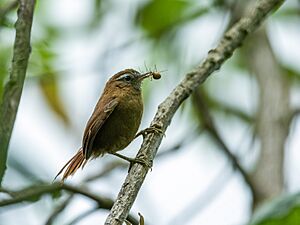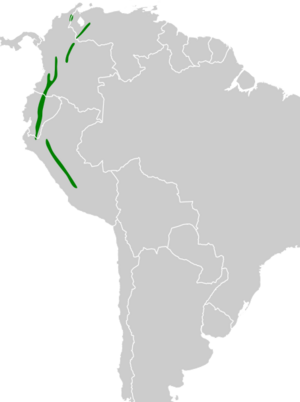White-browed spinetail facts for kids
Quick facts for kids White-browed spinetail |
|
|---|---|
 |
|
| at Pichincha, Ecuador | |
| Conservation status | |
| Scientific classification | |
| Genus: |
Hellmayrea
|
| Species: |
gularis
|
 |
|
| Synonyms | |
|
Synallaxis gularis |
|
The white-browed spinetail (Hellmayrea gularis) is a small bird that belongs to the ovenbird family, called Furnariidae. You can find this bird in the mountains of Colombia, Ecuador, Peru, and Venezuela. It's known for its short tail, which is unusual for a spinetail!
Contents
About the White-browed Spinetail
This bird is quite small, measuring about 11 to 13.5 centimeters (4.3 to 5.3 inches) long. It weighs around 11 to 15 grams (0.39 to 0.53 ounces), which is about the same as a few quarters. Both male and female white-browed spinetails look alike.
What Does It Look Like?
The white-browed spinetail has a special white stripe above its eyes, called a supercilium. These stripes almost meet on its forehead. Its face is a dark reddish-brown color. The top of its head and neck are also reddish-brown, with some faint lighter streaks.
Its back and wings are reddish-brown too. The tail is the same color, and the tips of its tail feathers are pointed and don't have the usual soft parts (barbs) that most feathers have.
The bird's throat is white, with a thin black band just below it. Its belly and chest are a plain cinnamon-brown to light brown color, sometimes with a hint of gray. Its eyes are dark brown. The top part of its beak is black or dark gray, and the bottom part is pinkish-horn or gray with a dark tip. Its legs and feet are olive, olive-brown, or olive-yellowish.
Young white-browed spinetails have dark tips on the feathers of their chest and belly.
Different Types of White-browed Spinetails
There are four different types, or subspecies, of the white-browed spinetail. They have slight differences in their colors:
- H. g. gularis: This is the main type, described above.
- H. g. brunneidorsalis: This one has browner upperparts and lighter, grayer underparts compared to the main type.
- H. g. cinereiventris: This type has darker, richer brown upperparts and brownish-gray underparts.
- H. g. rufiventris: This one is darker overall, with more reddish-brown upperparts and dark chestnut-colored underparts.
Where They Live and Their Home
White-browed spinetails live in the Andes mountains across several South American countries.
Where Each Type Lives
- H. g. gularis: You can find this type in the Andes of western Venezuela, all three Andean mountain ranges in Colombia, and on both sides of the Andes in Ecuador and northern Peru.
- H. g. brunneidorsalis: This type lives in the Serranía del Perijá, a mountain range on the border between northeastern Colombia and northwestern Venezuela.
- H. g. cinereiventris: This one is found in the Andes of western Venezuela, from Trujillo south to Táchira.
- H. g. rufiventris: This type lives in the Andes of northern and central Peru.
Their Favorite Places to Live
These birds love to live in elfin forests, which are misty, high-altitude forests with small, twisted trees. They also live in evergreen forests and the edges of cloudforests. They often hide in thick patches of Chusquea bamboo. You can find them at very high elevations, from about 2,300 to 3,900 meters (7,500 to 12,800 feet) above sea level.
How They Live
The white-browed spinetail stays in the same area all year round; it does not migrate.
What They Eat
White-browed spinetails mostly eat arthropods, which are small creatures like insects and spiders. They usually look for food alone or in pairs. Sometimes, they join groups of different bird species that are all foraging together.
They are very agile hunters! They hop and hitch their way up tree trunks and sometimes even hang upside down to reach their prey. They usually search for food in the dense undergrowth of the forest, and sometimes on the ground. They pick and poke for their food in moss, thick leaves, dead leaves, tree bark, and bamboo.
Vocalizations: What They Sound Like
The white-browed spinetail's song is a series of high-pitched notes that end in a trill. It sounds like "chit-chit-chit-chit-chi-chi-chichichichichichi" or "cheet teet-teet-ti-tititit". Their calls include a sudden "chip" and a "nasal descending trill." They also make repeated single "chiyt" or "tseet" notes.
Reproduction and Life Cycle
Right now, scientists don't know much about how the white-browed spinetail breeds or raises its young.
Conservation Status
The IUCN (International Union for Conservation of Nature) has listed the white-browed spinetail as a species of "Least Concern." This means they are not currently in danger of disappearing. They have a large area where they live, and their population size is thought to be stable, even though the exact number of birds isn't known. No immediate threats to their survival have been found. While they are considered fairly common in general, they can be harder to find in some areas of Venezuela.


